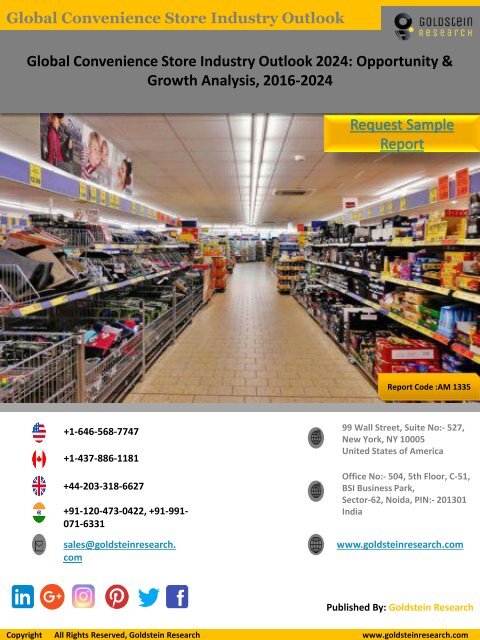Create successful ePaper yourself
Turn your PDF publications into a flip-book with our unique Google optimized e-Paper software.
Copyright All Rights Reserved, Goldstein Research www.goldsteinresearch.com<br />
Global <strong>Convenience</strong> <strong>Store</strong> <strong>Industry</strong> Outlook<br />
Global <strong>Convenience</strong> <strong>Store</strong> <strong>Industry</strong> Outlook <strong>2024</strong>: Opportunity &<br />
Growth Analysis, <strong>2016</strong>-<strong>2024</strong><br />
Request S<strong>amp</strong>le<br />
Report<br />
Report Code :AM 1335<br />
+1-646-568-7747<br />
+1-437-886-1181<br />
+44-203-318-6627<br />
+91-120-473-0422, +91-991-<br />
071-6331<br />
sales@goldsteinresearch.<br />
com<br />
99 Wall Street, Suite No:- 527,<br />
New York, NY 10005<br />
United States of America<br />
Office No:- 504, 5th Floor, C-51,<br />
BSI Business Park,<br />
Sector-62, Noida, PIN:- 201301<br />
India<br />
www.goldsteinresearch.com<br />
Published By: Goldstein Research
Copyright All Rights Reserved, Goldstein Research www.goldsteinresearch.com<br />
Global <strong>Convenience</strong> <strong>Store</strong> <strong>Industry</strong> Outlook<br />
• <strong>Convenience</strong> stores (C-stores) have seen dramatic growth across the globe, and<br />
more is set to come, both in terms of store counts and revenue. Although the<br />
layout and selection of goods offered in C-stores can differ greatly region to region,<br />
some of the major trends driving C-store proliferation—such as expansion of food<br />
categories, additional conveniences, and private label products—are shared across<br />
geographies.<br />
• The food category has become an essential component of C-store sales and<br />
profitability. In the U.S.—which has the world’s highest C-store count at XXX,000—<br />
food services sales accounted for XX% of total in-store sales of USD XX billion in<br />
<strong>2016</strong>, up from XX% of USD XX billion in 2012.<br />
Request S<strong>amp</strong>le<br />
Report<br />
Technological<br />
Advancements<br />
• In Japan, where C-stores number XX,000 (still high by world standards), food service<br />
items, including processed foods, fast food, and daily delivered food, made up XX%<br />
of fiscal <strong>2016</strong> convenience store business net sales for Lawson —the second-largest<br />
C-store chain in the country. In China, more than XX% of revenue for both Japanbased<br />
7-Eleven and Family Mart C-stores came from boxed lunches. And for<br />
Greencore Group, a dominant supplier of processed food to Cstores in the U.K.,<br />
saw XX% growth in its U.K. Food-to-Go category in 2014.<br />
• Emerging markets are also seeing more snacking as consumer trends become more<br />
westernized. In China, as the country progresses economically, there is evidence<br />
that middle-class workers snack more, as they have less time for traditional meals.<br />
In Vietnam, the growing economy coupled with a young population—the majority<br />
is under age 30—has led to growth in packaged foods, which are often purchased in<br />
modern retail channels, such as C-stores.<br />
• Another common trend is the use of private label brands to help C-stores grow<br />
their margins. Private-label brands generally tend to be of comparable quality to<br />
national brands, but more attractively priced.<br />
Global <strong>Convenience</strong> <strong>Store</strong> <strong>Industry</strong> Size (USD Billion)<br />
E-commerce<br />
Natural and<br />
Organic<br />
Products<br />
Fresh Foods<br />
and<br />
Vegetables<br />
<strong>2016</strong><br />
North America<br />
USD XX Billion<br />
Europe<br />
USD XX Billion<br />
<strong>2024</strong><br />
USD XX Billion<br />
USD XX Billion
Copyright All Rights Reserved, Goldstein Research www.goldsteinresearch.com<br />
Global <strong>Convenience</strong> <strong>Store</strong> <strong>Industry</strong> Size (USD<br />
Billion) & Growth Analysis<br />
Fig: 13: Global <strong>Convenience</strong> <strong>Store</strong> <strong>Industry</strong> Size (USD Billion)-<strong>2016</strong>-<strong>2024</strong><br />
XX<br />
Request S<strong>amp</strong>le<br />
Report<br />
XX<br />
XX<br />
XX<br />
XX<br />
XX<br />
XX<br />
XX<br />
XX<br />
XX<br />
XX<br />
XX<br />
XX<br />
XX<br />
XX<br />
XX<br />
<strong>2016</strong>e 2017e 2018 2019 2020 2021 2022 2023 <strong>2024</strong><br />
Source: Goldstein Research<br />
Global <strong>Convenience</strong> <strong>Store</strong> <strong>Industry</strong> is anticipated to expand at a compound<br />
annual growth rate of XX% during the forecast period i.e. <strong>2016</strong>-<strong>2024</strong>. The market is anticipated to reach<br />
USD XX Billion by the end of <strong>2024</strong>. Competition in the food retail market has increased in recent years.<br />
Traditional food retailers have faced fierce pressure from alternative channels including warehouse<br />
clubs, supercenters, drug stores, mass retailers and convenience stores, as well as online retailers and<br />
grocery delivery services. As consumers distance themselves from the traditional supermarket model,<br />
grocery retailers are attempting to stay competitive by creating more intimate and innovative shopping<br />
experiences tailored to individual shoppers with an emphasis on fresh, organic and prepared food<br />
options.<br />
Stiff competition, evolving consumer preferences and a challenging organic growth environment are<br />
driving many food retailers to evaluate their store and brand portfolios and consider strategic<br />
alternatives, including M&A, in order to optimize capital allocation and growth opportunities.<br />
Fresh food sales are increasing, along with consumer buzz and interest in eating and living well. In the<br />
U.S., XX% of grocery shoppers buy fresh products, and fresh perimeter aisles have become places where<br />
grocers establish their identities.
Growth Drivers<br />
Adding Further <strong>Convenience</strong>s<br />
‣ A second trend that is broadening the customer base of C-<br />
stores worldwide is the introduction of additional<br />
conveniences and services not traditionally associated with<br />
C-stores. These may not be direct revenue drivers, but they<br />
do attract more customers into stores, leading to more<br />
potential purchases. One of the most successful and<br />
widespread has been the installation of ATMs.<br />
‣ Success has also come from partnerships between e-<br />
commerce retailers for delivery and pick-up of packages at<br />
C-stores, which can be less costly and more convenient<br />
than home deliveries. In Taiwan, the four major C-store<br />
chains handle over 1 million packages every month. This<br />
service is so far more limited in the U.S., with Amazon<br />
(AMZN) paving the way with deliveries to 7-Eleven stores<br />
set up with lockers.<br />
‣ Other common new conveniences offered in the C-stores<br />
include ticket sales, utility payments, postal box service,<br />
and even parking ticket payments. For instance, 7-Eleven<br />
stores in Thailand recently began offering AirAsia booking<br />
and payment services. Japan, which again seems at the<br />
cuttingedge in C-store evolution, has begun selling nonprescription<br />
drugs and offering consultations with<br />
pharmacists/dieticians via video phones in its Lawson<br />
stores.<br />
Request S<strong>amp</strong>le<br />
Report<br />
Opportunities<br />
‣ Even with continued innovation in global,<br />
regional and local supply chain and delivery<br />
capabilities, the online-only grocery business<br />
model remains challenging. However,<br />
consumer demand for online food offerings has<br />
increased in recent years, providing an<br />
incentive for traditional brick-and-mortar<br />
retailers to enter the online segment.<br />
‣ Even with continued innovation in global,<br />
regional and local supply chain and delivery<br />
capabilities, the online-only grocery business<br />
model remains challenging. However,<br />
consumer demand for online food offerings has<br />
increased in recent years, providing an<br />
incentive for traditional brick-and-mortar<br />
retailers to enter the online segment.<br />
‣ The industry is incredibly dynamic and there is<br />
constant pressure to adapt formats to address<br />
evolving customer preferences. Larger players<br />
have been much more receptive to operating a<br />
broad portfolio of store formats, whether<br />
developed in house or through acquisition.<br />
XX%<br />
XX%<br />
XX%<br />
XX%<br />
XX%<br />
XX%<br />
XX%<br />
Fig: 5-3 Influence of Mobile Loyalty Programs in Selecting C-<strong>Store</strong>sby<br />
Different Generations (%)<br />
XX%<br />
XX%<br />
XX%<br />
XX%<br />
Impact Analysis:-<br />
• Growth in healthy food and beverages<br />
sales led to positive overall sales at<br />
convenience stores in 2017, and retailers<br />
expect the momentum to continue in<br />
2018, according to a survey of retailers<br />
released today by the National Association<br />
of <strong>Convenience</strong> <strong>Store</strong>s (NACS).<br />
• Competition for the convenience store<br />
customer is the top concern of retailers<br />
heading into 2018, with nearly half (XX%)<br />
saying that they expect to continue<br />
competing with other channels and other<br />
convenience and fuel retailers (XX%).<br />
XX%<br />
Millenials Generation X Baby Boomers Silent Generation<br />
Source: Goldstein Research<br />
Impact on Global<br />
<strong>Convenience</strong> <strong>Store</strong><br />
<strong>Industry</strong><br />
High Medium Low<br />
Copyright All Rights Reserved, Goldstein Research www.goldsteinresearch.com
Copyright All Rights Reserved, Goldstein Research www.goldsteinresearch.com<br />
<strong>Market</strong> Restraints<br />
Growing Competition<br />
Request S<strong>amp</strong>le<br />
Report<br />
‣ <strong>Convenience</strong> retailing continues to evolve and change globally. Yet in light of competition from other retailers such as<br />
supermarkets and quick service restaurants, and emerging lifestyle trends like healthier eating and living, major convenience<br />
stores may not be seen as meeting these competitive and business challenges.<br />
‣ Even with the evolving channel landscape, convenience stores will continue to grow, with new stores leading the charge.<br />
They will also claim an increased percentage of channel spend as well, albeit not at the same pace as e-commerce.<br />
‣ As a consequence of several consumer shifts, including digital technology usage and driving trends, Americans are making<br />
fewer shopping trips than just a few years ago. According to Nielsen Homescan data, the total number of U.S. retail trips is<br />
down more than XX million since 2012 (XX billion in <strong>2016</strong>, vs. XX billion in 2012).<br />
‣ Aside from food and store layout, convenience retailers need to be continually innovative. The includes marketing more<br />
intelligently and across digital platforms, developing personalized offers and rewards that are determined directly by<br />
individualized consumer shopping and purchase habits.<br />
Fig: 17: Total Number of Conventional <strong>Store</strong>s (Thousand),<br />
2012 - 2017<br />
XX<br />
XX<br />
XX<br />
XX<br />
XX<br />
XX<br />
XX<br />
XX<br />
XX<br />
XX<br />
XX<br />
XX<br />
XX<br />
Source: Goldstein Research<br />
XX<br />
2012 2013 2014 2015 <strong>2016</strong> 2017<br />
XX<br />
XX<br />
XX<br />
Impact Analysis:-<br />
• Especially today, it is crucial that grocery<br />
store managers understand exactly what<br />
their customers need - and then provide<br />
exactly what their customers need.<br />
Grocery stores in particular feel the burn<br />
of competition because there are so many<br />
stores that are similar that it is incredibly<br />
easy for a customer to walk in, not find<br />
what they want, and then walk right back<br />
out and into the doors of another similar<br />
store that has that one extra item that the<br />
other store did not.<br />
• Grocery stores typically have lower profit<br />
margins than other stores, so it is even<br />
more important that they are constantly<br />
on top of ways to run their operation<br />
cleanly and efficiently. Labor costs are one<br />
of the only costs that a retailer can<br />
control, and so a grocery store should be<br />
on that like white on rice.<br />
High Medium Low<br />
Impact on Global<br />
<strong>Convenience</strong> <strong>Store</strong> <strong>Industry</strong>
Global <strong>Convenience</strong> <strong>Store</strong> <strong>Industry</strong> Outlook :<br />
<strong>2016</strong>-<strong>2024</strong><br />
Request S<strong>amp</strong>le<br />
Report<br />
Fig: 17: Global <strong>Convenience</strong> <strong>Store</strong> <strong>Industry</strong> <strong>Share</strong>, By Product Type,<br />
<strong>2016</strong>-<strong>2024</strong><br />
XX%<br />
XX%<br />
XX%<br />
<strong>2016</strong><br />
XX%<br />
XX%<br />
XX%<br />
Source: Goldstein Research<br />
Food<br />
Beverages<br />
Tobacco<br />
Snacks and<br />
Candies<br />
Others<br />
Fuel<br />
Fig: 17: Global <strong>Convenience</strong> <strong>Store</strong> <strong>Industry</strong> Y-O-Y Growth, By<br />
Product Type, , <strong>2016</strong>-<strong>2024</strong><br />
XX%<br />
XX%<br />
XX%<br />
<strong>2024</strong><br />
XX%<br />
XX%<br />
XX%<br />
•As per Global Retail Development<br />
Index (GRDI) countries from Asia-<br />
Pacific such as India, China, and<br />
Malaysia topped the GRDI list in<br />
terms of both size and momentum<br />
thus proving to be potential to<br />
develop convenience store market<br />
which is at an initial stage. But U.S.<br />
has existing huge market of<br />
convenience store owing to the sale<br />
of fuel and packed food available at<br />
these stores located along the<br />
roadside, in an urban area or inside<br />
a transport hub.<br />
•This industry has grown over the<br />
past five years, benefitting from a<br />
strengthening economy and the<br />
trend toward organic and allnatural<br />
brands, especially as<br />
consumer spending has increased.<br />
However, the industry is mature,<br />
and revenue is expected to grow at<br />
a rate below national GDP over the<br />
next five years (XX%, annualized) as<br />
compared to annualized growth of<br />
XX% from 2012 to 2017.<br />
<strong>2016</strong>e 2017f 2018f 2019f 2020f 2021f 2022f 2023f <strong>2024</strong>f<br />
•Generally, over XX% of a c-store’s<br />
sales are motor fuels; however, fuel<br />
typically contributes only one-third<br />
of total convenience store gross<br />
margin dollars<br />
Fig: 17: Global <strong>Convenience</strong> <strong>Store</strong> <strong>Industry</strong> Size (USD Billion), By ProductType-<strong>2016</strong>-<strong>2024</strong><br />
XX<br />
XX<br />
XX XX<br />
XX<br />
XX<br />
XX<br />
XX<br />
XX<br />
XX<br />
XX<br />
XX<br />
<strong>2016</strong> <strong>2024</strong><br />
Fuel<br />
Source: Goldstein Research<br />
Food2 Beverages2 Tobacco2 Snacks and Candies2 Others2<br />
Copyright All Rights Reserved, Goldstein Research www.goldsteinresearch.com
Global <strong>Convenience</strong> <strong>Store</strong> <strong>Industry</strong> Outlook :<br />
<strong>2016</strong>-<strong>2024</strong><br />
Request S<strong>amp</strong>le<br />
Report<br />
Fig: 17: Global <strong>Convenience</strong> <strong>Store</strong> <strong>Industry</strong> <strong>Share</strong>, By Food Products,<br />
<strong>2016</strong>-<strong>2024</strong><br />
XX<br />
XX<br />
XX<br />
XX<br />
XX<br />
XX<br />
XX<br />
XX<br />
XX<br />
XX<br />
XX<br />
XX<br />
XX<br />
XX<br />
XX<br />
Fig: 17: Global <strong>Convenience</strong> <strong>Store</strong> <strong>Industry</strong> Y-O-Y Growth, By Food<br />
Product Type, , <strong>2016</strong>-<strong>2024</strong><br />
<strong>2016</strong>e 2017f 2018f 2019f 2020f 2021f 2022f 2023f <strong>2024</strong>f<br />
XX<br />
<strong>2016</strong>e 2017e 2018f 2019 2020 2021 2022 2023 <strong>2024</strong><br />
Source: Goldstein Research<br />
XX<br />
XX<br />
XX<br />
XX<br />
•Recent snacking statistics support<br />
the idea that C-store food<br />
consumption should continue to<br />
climb. According to Goldstein<br />
research, eating habits are shifting<br />
from the standard three meals a<br />
day to more frequent snacking,<br />
with snacking accounting for half of<br />
all eating occasions in the U.S. The<br />
study also found that when<br />
purchasing food for immediate<br />
consumption, consumers are four<br />
times more likely to visit a C-store<br />
than when food shopping for nonimmediate<br />
consumption.<br />
•Global consumption of fresh food<br />
grew XX% in <strong>2016</strong> versus 2015.<br />
Further, the global “functional<br />
food” market—defined as foods<br />
that have a potentially positive<br />
effect on health beyond basic<br />
nutrition—is estimated to have<br />
generated revenues of<br />
approximately USD XX billion in<br />
2013. With its annual average<br />
growth rate of XX%, that puts it on<br />
track to reach USD XX billion by<br />
2015. C-stores recognize that<br />
meeting this new demand for fresh<br />
or more nutritional food is essential<br />
to growing revenue.<br />
Fig: 17: Important Factors Consumers Consider in Selecting a Conventional <strong>Store</strong> to Purchase a Meal<br />
Family-Friendly Environment<br />
Healthy Food<br />
Key Decision Factors<br />
Food/Menu Variety<br />
Food Quality<br />
Price<br />
Location<br />
Source: Goldstein Research 0% 5% 10% 15% 20% 25% 30% 35% 40% 45% 50%<br />
Copyright All Rights Reserved, Goldstein Research www.goldsteinresearch.com
CAGR (%)<br />
Global <strong>Convenience</strong> <strong>Store</strong> <strong>Industry</strong> Attractiveness and<br />
BPS Analysis by Rental Type, <strong>2016</strong>-<strong>2024</strong><br />
Fig: 17: Global <strong>Convenience</strong> <strong>Store</strong> <strong>Industry</strong> Attractiveness-By Product Type, <strong>2016</strong>-<strong>2024</strong><br />
XX%<br />
XX%<br />
Request S<strong>amp</strong>le<br />
Report<br />
XX%<br />
XX%<br />
XX%<br />
XX%<br />
XX%<br />
XX%<br />
XX XX XX XX XX XX XX XX XX XX<br />
<strong>Market</strong> Size (USD Million)<br />
Food Beverages Tobacco Products Fuels Snacks and Candies Others<br />
Source: Goldstein Research<br />
Fuel holds the largest revenue share in the global convenience store industry. Meanwhile, new rivals are<br />
shaking up the market for c-stores’ traditional offerings like in-store merchandise and fuel. Amazon’s new<br />
brick-and-mortar stores and Walmart’s move to a smaller store format in urban areas are cases in point.<br />
Cigarettes remain an important category for c-stores, constituting roughly XX% of in-store sales. But in the<br />
long term, the category could shrink in size compared with other tobacco products. In all foodservice<br />
segments, players are jockeying to win on-the-go and bargain-minded consumers. And the competition<br />
will only stiffen. For one thing, segment rivals are encroaching on c-stores’ playing field. For ex<strong>amp</strong>le,<br />
some grocery chains and mass-merchant competitors are expanding their convenience and prepared-food<br />
offerings, and some are moving to a small-box format<br />
Fig: 17: Global <strong>Convenience</strong> <strong>Store</strong> <strong>Industry</strong> BPS Analysis- By Type <strong>2016</strong>-<strong>2024</strong><br />
160%<br />
140%<br />
120%<br />
100%<br />
80%<br />
XX%<br />
XX%<br />
XX%<br />
XX%<br />
XX%<br />
XX%<br />
XX%<br />
XX%<br />
Others<br />
Snacks and Candies<br />
Tobacco<br />
60%<br />
XX%<br />
XX%<br />
Beverages<br />
40%<br />
Food<br />
20%<br />
XX%<br />
XX%<br />
Fuel<br />
0%<br />
<strong>2016</strong> <strong>2024</strong><br />
Source: Goldstein Research<br />
Copyright All Rights Reserved, Goldstein Research www.goldsteinresearch.com
North America <strong>Convenience</strong> <strong>Store</strong> <strong>Industry</strong> Size<br />
(USD Billion) & Y-O-Y growth (%), By Region- <strong>2016</strong>-<br />
<strong>2024</strong><br />
North America <strong>Convenience</strong> <strong>Store</strong> <strong>Industry</strong> Size (USD Billion)-<strong>2016</strong>-<strong>2024</strong><br />
XX<br />
XX<br />
XX<br />
XX<br />
XX<br />
XX%<br />
CAGR: (<strong>2016</strong>-<strong>2024</strong>)<br />
XX<br />
XX<br />
XX<br />
XX<br />
XX<br />
XX<br />
Request S<strong>amp</strong>le<br />
Report<br />
XX%<br />
XX XX%<br />
XX<br />
XX%<br />
XX%<br />
XX%<br />
XX%<br />
XX<br />
XX<br />
XX%<br />
XX% XX% XX% XX% XX%<br />
XX%<br />
XX%<br />
XX%<br />
XX%<br />
XX<br />
XX%<br />
XX<br />
XX%<br />
XX<br />
<strong>2016</strong>e 2017e 2018f 2019f 2020f 2021f 2022f 2023f<br />
Source: Goldstein Research<br />
North America North America <strong>Convenience</strong> <strong>Store</strong><br />
<strong>Industry</strong> Size (USD Billions), By Country-<strong>2016</strong>-<strong>2024</strong><br />
-XX%<br />
North America North America <strong>Convenience</strong> <strong>Store</strong><br />
<strong>Industry</strong> Size (USD Billion), By Product Type-<strong>2016</strong>-<br />
<strong>2024</strong><br />
XX<br />
XX<br />
XX%<br />
XX<br />
XX<br />
XX<br />
XX<br />
XX%<br />
XX%<br />
XX%<br />
XX%<br />
XX<br />
XX<br />
XX<br />
XX<br />
XX<br />
XX<br />
XX<br />
XX<br />
XX<br />
XX<br />
XX%<br />
XX%<br />
XX%<br />
<strong>2016</strong> <strong>2024</strong><br />
<strong>2016</strong> <strong>2024</strong><br />
Fuel Food2 Beverages2<br />
US<br />
Canada<br />
Tobacco2 Snacks and Candies2 Others2<br />
Source: Goldstein Research<br />
Source: Goldstein Research<br />
Copyright All Rights Reserved, Goldstein Research www.goldsteinresearch.com
Copyright All Rights Reserved, Goldstein Research www.goldsteinresearch.com<br />
United States <strong>Convenience</strong> <strong>Store</strong> <strong>Industry</strong> Size (USD<br />
Billion) & Y-O-Y growth (%), <strong>2016</strong>-<strong>2024</strong><br />
XX<br />
XX<br />
XX<br />
XX<br />
XX<br />
XX%<br />
CAGR: (<strong>2016</strong>-<strong>2024</strong>)<br />
XX<br />
XX<br />
XX<br />
XX<br />
XX<br />
Request S<strong>amp</strong>le<br />
Report<br />
United States <strong>Convenience</strong> <strong>Store</strong> <strong>Industry</strong> Size (USD Billion), Compound Annual Growth Rate<br />
(%), Y-O-Y Growth Rate (%), <strong>2016</strong>-<strong>2024</strong><br />
XX<br />
XX<br />
XX%<br />
XX%<br />
XX%<br />
XX%<br />
XX%<br />
XX<br />
XX%<br />
XX<br />
XX<br />
XX%<br />
XX% XX% XX% XX% XX%<br />
XX%<br />
XX%<br />
XX%<br />
XX%<br />
XX<br />
XX%<br />
XX<br />
XX%<br />
XX<br />
<strong>2016</strong>e 2017e 2018f 2019f 2020f 2021f 2022f 2023f<br />
Source: Goldstein Research<br />
-XX%<br />
Key Insights<br />
Fig: 24: U.S Increase in No. of <strong>Convenience</strong><br />
<strong>Store</strong>s, 2012-<strong>2016</strong><br />
The U.S. convenience store count increased to<br />
XXX,000 stores as of December 31, 2017, a XX%<br />
increase (XXX stores) from the year prior. Overall,<br />
nearly 80% of convenience stores (XXX thousand<br />
total) sell fuel<br />
Single-store operators within the convenience retail<br />
space also increased by XX units (XX%), up from<br />
XX,000 stores at year-end <strong>2016</strong> to XXXX stores at<br />
year-end 2017. Further, the supermarkets and<br />
grocery store industry makes up the largest food<br />
retail channel in the United States. <strong>Industry</strong><br />
revenue totaled approximately USD XX billion in<br />
<strong>2016</strong>, and profit was USD XX billion<br />
XX<br />
XX<br />
XX<br />
XX<br />
XX<br />
XX<br />
XX<br />
XX<br />
XX<br />
<strong>2016</strong> 2017 2018 2019 2020 2021 2022 2023 <strong>2024</strong><br />
Source: Goldstein Research<br />
C-stores in North America should continue to grow, as small-format stores are projected to see a XX%<br />
CAGR from <strong>2016</strong> to <strong>2024</strong> versus XX% for big-box stores. According to Goldstein Research, XX% of<br />
current retail sales growth is coming from stores of 35,000 square feet and smaller, and over one-third<br />
of that portion is coming from stores 5,000 square feet or smaller. In the U.S., C-stores have grown by<br />
over XX% from 1984 to 2013, to approximately XXX,000 stores. However, the top 100 convenience<br />
store operators only account for XX% of the stores and the top XX account for XX%.
Copyright All Rights Reserved, Goldstein Research www.goldsteinresearch.com<br />
Global <strong>Convenience</strong> <strong>Store</strong> <strong>Industry</strong> Outlook<br />
Alimentation Couche-Tard (Company Overview & Business Strategy)<br />
Request S<strong>amp</strong>le<br />
Report<br />
Founded<br />
1980<br />
Employees<br />
120,000<br />
Headquarters<br />
Canada<br />
Website<br />
www.couche-tard.com<br />
Company Overview<br />
• Alimentation Couche-Tard Inc. or simply Couche-Tard is<br />
one of the largest company-owned convenience store<br />
operators in the world with around 15,000 stores<br />
across Canada, the United States, Europe, Mexico,<br />
Japan, China, and Indonesia.<br />
• The company primarily generates income through the<br />
sale of tobacco products, groceries, beverages, fresh<br />
food, quick service restaurants, car wash services, other<br />
retail products and services, road transportation fuel,<br />
stationary energy, marine fuel, and chemicals.<br />
• In addition, the company operates more stores under<br />
the Circle K banner in other countries such as China,<br />
Egypt, and Malaysia. Its operation is geographically<br />
divided into U.S., Europe, and Canada.<br />
• Revenue from external customers fall mainly into three<br />
categories: merchandise and services, road<br />
transportation fuel, and other.<br />
Business Segments<br />
Population Health Management<br />
Clinical Solutions<br />
Open & Interoperable Solutions<br />
Service and Technology<br />
Revenue Cycle Management<br />
Business Strategy<br />
Expansion and Investment Strategy: Couche-Tard has structured its field organization to allow it to<br />
preserve local innovation with the goal of engendering future ideas that it can extend globally, according<br />
to the report. Its business unit leaders, each supported by a full management team, manage no more than<br />
500 stores. This allows them to operate like their own companies, and to visit every one of their stores at<br />
least once a year. In Europe, Couche-Tard operates a broad retail network across Scandinavia (Norway,<br />
Sweden and Denmark), Poland, the Baltics (Estonia, Latvia and Lithuania) and Russia under the Statoil and<br />
Ingo brands. As of Oct. 11, 2015, it comprised 2,217 stores, the majority of which offer fuel and<br />
convenience-store products, while the others are unmanned automated gas stations that offer fuel only.
Copyright All Rights Reserved, Goldstein Research www.goldsteinresearch.com<br />
Global <strong>Convenience</strong> <strong>Store</strong> <strong>Industry</strong> Outlook<br />
Request S<strong>amp</strong>le<br />
Report<br />
Thank you<br />
Connect With Us:<br />
Published By: Goldstein Research


















